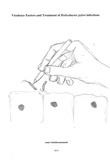Virulence Factors and Treatment of Helicobacter pylori infections

Talebibezminabadi, Amin
- Promoter:
- Prof.dr. J.A. (Jaap) Wagenaar
- Co-promoter:
- Dr. J.G. (Hans) Kusters
- Research group:
- Wagenaar
- Date:
- November 12, 2013
- Time:
- 10:30 h
Summary
Helicobacter pylori is a Gram-negative, spiral shaped bacterium that colonizes the epithelial mucosa of the human stomach of more than 50% of the worlds population. Colonization typically occurs during early childhood, and if left untreated it usually lasts for life. The long-term persistence of H. pylori induces a multifaceted immune response. Instead of clearing the infection the immune response results in prolonged mucosal injuries leading to atrophy, intestinal metaplasia, and dysplasia. This immunity induced self-damage makes H. pylori the most common etiologic agent of gastritis, peptic ulcer disease, mucosa-associated lymphoid tissue lymphoma, and gastric adenocarcinoma. Currently the only effective therapy of the H. pylori infected patient is treatment with antimicrobials, but the efficacy of therapeutic regimens is rapidly decreasing due to the development of antimicrobial resistance. When we tested for antimicrobial resistance levels in the Northern Iranian population we found a high frequency of antimicrobial resistance for the commonly used anti H. pylori drugs clarithromycin and metronidazole. The resistance for the newly introduced drug moxifloxacine was still low, but is predicted to raise rapidly. The increasing rate of antimicrobial resistance is probably related to high frequency of antimicrobials used to treat both H. pylori infections and other infectious diseases. This increase in resistance is alarming if it continues to increase at this rate as there will be no options left to treat those with an H. pyloriinfection. Luckily only a minority of the H. pylori infected people suffer from disease symptoms. While the exact reason for this is unclear, it is thought that the close interplay of host, environmental and bacterial factors determines the final outcome of the infection. With H. pylori there is a wide variation in these bacterial factors, and the presence/absence of many of these so called bacterial virulence factors has been found to be associated with specific H. pylori induced disease outcomes. In the tested Northern Iranian population we observed a significant increase of bacterial strains that carried certain virulence factors (e.g. tnpA and dupA) in patients with a specific gastroduodenal disease type. Our results are based on associations only and thus they cannot provide any insight into the biological mechanisms that explain the observed linkage with disease types. Also they should not be generalized without confirmatory studies from other geographical regions of the world. In spite of these potential shortcomings we postulate that the presence/absence of these bacterial virulence factors may serve as biomarkers to predict the outcome of the H. pylori infection. In the light of the rapidly decreasing efficacy of therapeutic regimens due to the vast increase of antimicrobial resistance in H. pylori this may be a valuable tool for the physicians to identify those patients that need H. pylori eradication.